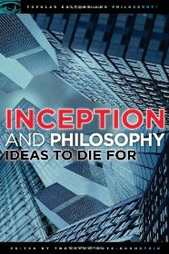| Note that the book itself contains 21 separate essays by different authors. This is part of the eleventh one by Emilie Dionne. (This extract was actually much larger, and approved by the author, but I have reduced it to around 400 words since copyright is owned by the publisher.) The Story-Making of Reality Story-telling is a process through which perception and creativity are intermeshed together in such a dynamic and progressive way that it becomes almost impossible to perceive the movement from perception to creation. Yet to create analogies is also to partly misconstrue what we see. This is due to the fact that, because of our embodied condition and the need to make decisions, we have only a certain amount of time to reflect on the course of action to follow. In Inception, the characters are limited by the projections of the subject's subconscious; they need to decide quickly on what to do next before the projections catch up with them. This is also brought to our attention as Saito is shot by Fisher's projections. Even if, in the state of dream, time expands, external events require of Cobb's team that they act with no time wasted. in dreams as in reality, we constantly face the contingency of a dynamic world. Therefore, the passage from ignorance to knowledge is carried out through translation, which in also quite unstable. To know means to understand what is unknown through what we already know. And, in this process, what we already know and what we just learnt mutually contaminate each other. To perceive what is unknown means to translate and interpret it through past experiences and through what in already know. Simultaneously, what we already know is transformed by the new analogy we perceive and create between the two things. Art is a good example: a new art movement, such as cubism or expressionism, will expand our understanding of art, and retrospectively we will reassess other work of art in relation to this new development. We don't look at art the same way before and after Picasso. To perceive is to interpret; it's not a perfect translation of what things are in and of themselves. Given this constant state of contingency, our lives depend on our capacity to stabilize, momentarily, what surrounds us. As embodied beings, there's another illusion that we need to acknowledge: the fiction of a stable and autonomous self. We're vulnerable due to our bodily limitations; we depend on others to understand our words and our gestures to communicate. Yet at all times, our body can experience trauma or illness. But as pointed out by Cobb, even ideas can change us. Thus to think of ourselves as stable entities is, at best, a temporary fact.
|
|||
|
|||


www.advaita.org.uk
Advaita for the 21st Century



Book Extract
Dreams as Realities
Emilie Dionne

Emilie Dionne is a graduate student in political studies from the university of Ottawa and currently completing a PhD in Political Theory at York University, Toronto. Her academic interests include feminist epistemologies, French contemporary philosophy, biopolitics, and environmental ethics.
She is also an artist, creating and selling drawings and acrylic paintings, under the name of Syphiell, with several websites.
Main website:
Biography
BOOK DETAILS
Publisher: Open Court Publishing Company
ISBN: 978-0-8126-9733-9
Format : Paperback
Pages: 319
List Price: £13.99, US$19.95
Where to Buy
AUTHOR DETAILS

